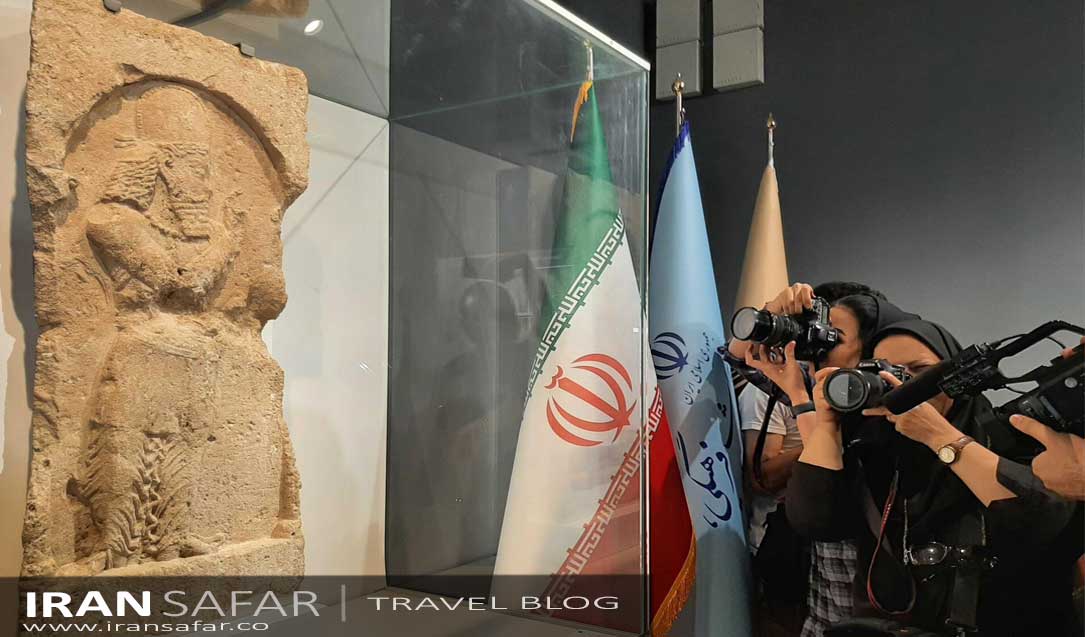In a remarkable turn of events, the long-lost Sassanid Soldier bas-relief, which was illegally taken out of Iran 35 years ago, has finally been returned back home. It was confiscated in England in 2016 and returned to Iran on 7 July 2023. According to the announcement of the Public Relations and Information Center of MCTH (Iran’s Ministry of Cultural Heritage, Tourism and Handicrafts), with the actions and follow-ups of the Ministry, this petroglyph has been reclaimed. After passing the necessary steps, this historical object will be displayed in the National Museum of Iran, the time of which will be announced. According to the charge d’affaires of Iran in London, there are further smuggled antiquities belonging to Iran, which the government is pursuing for their return.
The Story of the Sassanid Soldier Bas-Relief
The tale of the Sassanid Soldier bas-relief begins with its disappearance from Iran three and a half decades ago. The intricately carved stone panel, dating back to the Sasanian Empire (224-651 CE), vanished under dubious circumstances, leaving historians and art enthusiasts baffled. The journey of this artwork, which showcases the cultural richness of the Sassanid era, took an unexpected turn when it resurfaced in an international auction.
British Border Force officers encountered a suspicious package at London’s Stansted Airport in 2016, which was packed in a completely sloppy way to pretend it was not a valuable item. But according to the announcement of the Guardian newspaper of England, they came across a one-meter high relief that British Museum experts claim belongs to the Sassanid Iran and was cut from a rock around Shiraz to be sold at an auction in London.
Also Read : Naqsh-e Rostam
Theft from Iran discovered in England
This petroglyph, which is one of the works stolen from Iran, was discovered and confiscated in Britain about 7 years ago. It was originally belonging to one of the ancient sites of Iran known as the Sassanid Archaeological Landscape of Fars and is very similar to Sasanian bas-reliefs in Taq-e Bostan . After the illicit removal, the object was smuggled into the UAE in 1988 and left there in 2006. Although the exact time of the departure from Iran is unknown, but according to the time of its arrival in the UAE, which coincides with 1988, it is likely that this work was illegally imported from abroad during the war Irano-Iraq and confiscated in Britain in 2016.
This ancient work that was smuggled into England was discovered and confiscated in 2016 at Stansted Airport in London. Supposed to be exhibited in the British Museum on loan for 3 months after proving its ownership to Iran, this petroglyph remained there for almost 7 years.
Also Read : Iran’s Top Places to Visit
International Auction and Legal Battle
News of the auction spread like wildfire, and Iranian authorities were quick to identify the stolen artifact. Recognizing the significance of reclaiming their cultural heritage, they launched a legal battle to retrieve the Sassanid Soldier bas-relief. The case garnered widespread attention and put a spotlight on the illegal trade of antiquities.
Also Read – History of Iran
The right to be withdrawn
In recent years, a number of objects that were taken out of our country years ago have been returned to Iran with the consultations that have taken place. The first media that announced the existence of this petroglyph in the British Museum was the Guardian newspaper. The Guardian wrote that the smuggled bas-relief was seized at the London airport by the British Border Patrol and is to be exhibited in the British Museum before returning to Iran. Officials of the British Museum have announced that they have received permission from the Iranian government to display this ancient treasure for 3 months, and then they will send it to the National Museum in Tehran. The Sassanid relief (Sassanid soldier) was transferred to Iran on the morning of Wednesday, July 7, after being displayed in the British Museum for 3 months.
Importance of the Sassanid Soldier Bas-Relief
A Window into Sassanid Artistry: The Sassanid Soldier bas-relief provides invaluable insights into the artistic prowess and military grandeur of the Sassanid Empire. Carved with meticulous detail, it showcases the mastery of Sassanid sculptors in capturing the human form and depicting military attire and weaponry. The bas-relief stands as a testament to the artistic achievements of the time, serving as a visual record of the Sassanid Empire’s glory. By reclaiming the bas-relief, Iran has regained a piece of its history and reaffirmed its commitment to preserving its cultural identity for future generations.
FAQs




Dear Masoud Sa’adati,
Thank for your clearance comment on this article. This historic work is now kept in Iran national museum and will undergo further analyze by local archaeologists and experts.
The authenticity of this Sassanid soldier bas-relief can be doubted! The frames of the Sasanian motifs are all either rectangular or irregular, and there is no Sasanian relief that has a regular frame at the top. Another issue is that the work in England that is claimed to be from the Sassanid period is the smallest relief ever seen from this period. Of course, the crown (or hat) of the relief is similar to those of the Sassanid figures, but it is shorter than the crown of other motifs. The crown is similar to the crown of the people present in the relief of Bahram II in Naqsh-e Rostam and Sarab-e Bahram, but with the difference: it is shorter and there is no family sign on it (which is normally seen in other prototypes). The upper torso of the work is not similar to the Sasanian petroglyphs, but the lower body is well designed. In addition, the body shape of the engraved person is not the same as the existing reliefs from the Sassanid period, and the body shape is irregularly carved.